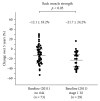Locomotive Syndrome Stage 1 Predicts Significant Worsening of Future Motor Performance: The Prospective Yakumo Study
- PMID: 31687379
- PMCID: PMC6794969
- DOI: 10.1155/2019/1970645
Locomotive Syndrome Stage 1 Predicts Significant Worsening of Future Motor Performance: The Prospective Yakumo Study
Abstract
Purpose: Aging of society has increased the need for prolongation of a healthy lifespan through maintenance of physical function. Prediction of future physical function may be possible by screening for stage 1 locomotive syndrome (LS). In this prospective study, we examined the influence of LS stage 1 at baseline (2011) on physical performance after 5 years (2016) in a community-dwelling cohort.
Methods: The participants were elderly adults aged >40 years who attended public health checkups as part of the Yakumo Study. LS screening in 2011 and 2016 was performed using the 25-question geriatric locomotive function scale (GLFS-25), the stand-up test, and the two-step test. LS of stage 1 or 2 was defined if the participant met the criteria in any of the three tests. Participants not meeting LS criteria were defined as the no risk group. Physical performance tests (10 m gait time, back muscle strength, 3 m TUG, and maximum stride) were also performed in 2011 and 2016.
Results: A total of 113 subjects (49 males, 64 females; average age 65.0 years) were followed from 2011 to 2016. At baseline, 73 (65%) had no risk, 29 (25%) had stage 1 LS, and 11 (10%) had stage 2 LS. Five years later, 51 (45%) had no risk, 45 (40%) had stage 1 LS, and 17 (15%) had stage 2 LS. Of the 73 subjects with no risk at baseline, 23 (32%) had stage 1 LS and 1 (1%) had stage 2 LS after 5 years. The baseline stage 1 LS group had significantly worse physical performance after 5 years, compared to the baseline no risk group (p < 0.05).
Conclusions: This longitudinal study showed that stage 1 LS screening is important for prevention of motor dysfunction in middle-aged and elderly people.
Copyright © 2019 Kazuyoshi Kobayashi et al.
Conflict of interest statement
The authors declare that they have no conflicts of interest.
Figures






References
-
- Imagama S., Hasegawa Y., Wakao N., Hirano K., Hamajima N., Ishiguro N. Influence of lumbar kyphosis and back muscle strength on the symptoms of gastroesophageal reflux disease in middle-aged and elderly people. European Spine Journal. 2012;21(11):2149–2157. doi: 10.1007/s00586-012-2207-1. - DOI - PMC - PubMed
-
- Imagama S., Hasegawa Y., Wakao N., Hirano K., Muramoto A., Ishiguro N. Impact of spinal alignment and back muscle strength on shoulder range of motion in middle-aged and elderly people in a prospective cohort study. European Spine Journal. 2014;23(7):1414–1419. doi: 10.1007/s00586-014-3251-9. - DOI - PubMed
-
- Imagama S., Hasegawa Y., Ando K., et al. Staged decrease of physical ability on the locomotive syndrome risk test is related to neuropathic pain, nociceptive pain, shoulder complaints, and quality of life in middle-aged and elderly people—the utility of the locomotive syndrome risk test. Modern Rheumatology. 2017;27(6):1051–1056. doi: 10.1080/14397595.2017.1285856. - DOI - PubMed
MeSH terms
LinkOut - more resources
Full Text Sources
Miscellaneous

